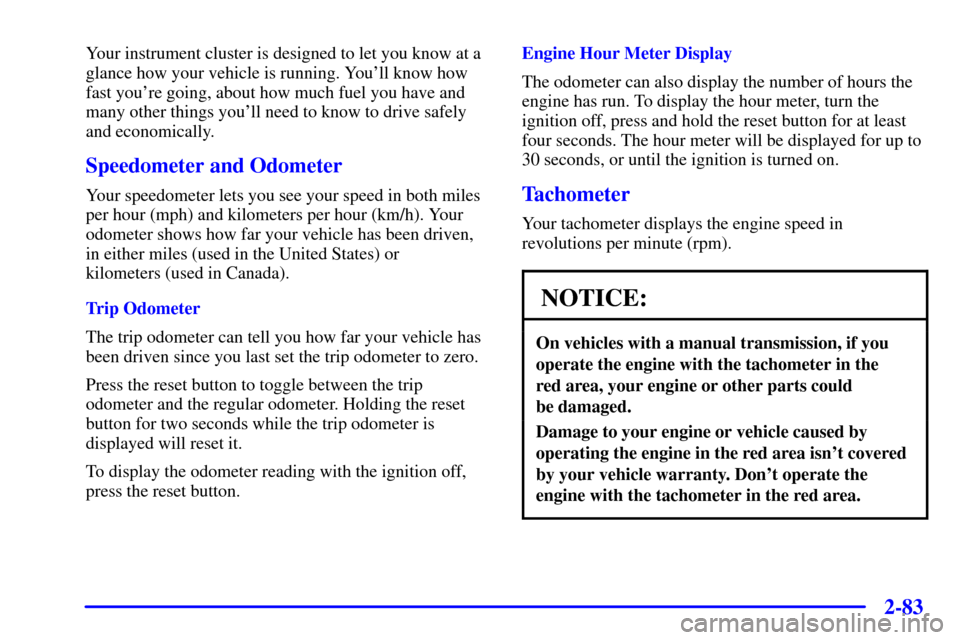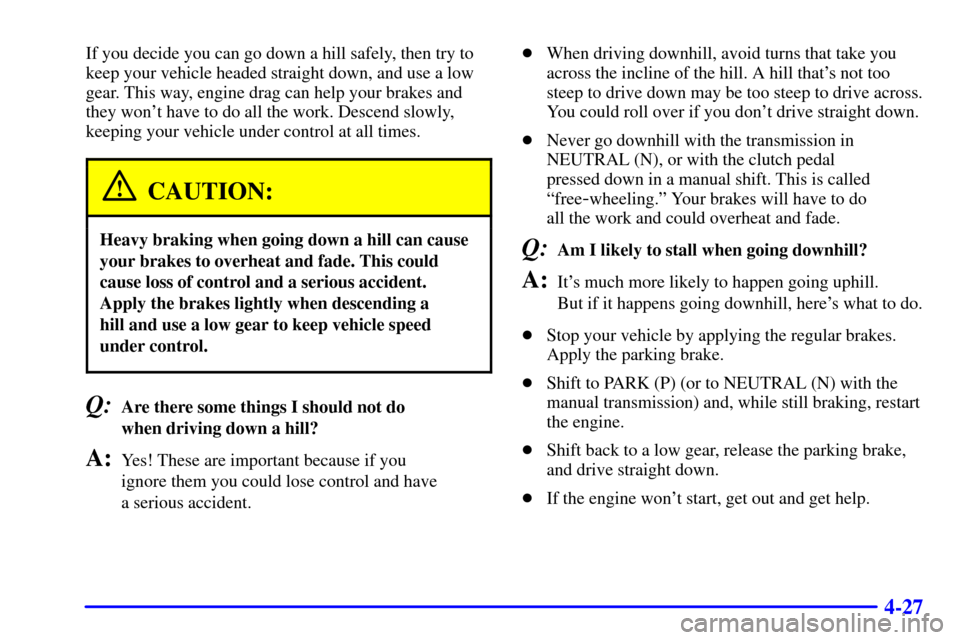Page 164 of 468
2-81
The main components of your instrument panel are the following:
A. Dome Lamp Switch
B. Lamp Controls
C. Air Outlets
D. Automatic Transfer Case (If Equipped)/Electronic
Transfer Case (If Equipped)/Traction Assist
System (If Equipped)
E. Multifunction Lever
F. Instrument Cluster
G. Gearshift Lever (Automatic Transmission)
H. Tow/Haul Selector Switch
I. Audio System
J. Comfort Control SystemK. Glove Box
L. Passenger Air Bag Off Switch
M. Manual Selectable Ride Control (If Equipped)
N. Ashtray
O. Storage Area or Compact Disc Player (If Equipped)
P. Rear Window Defogger Switch (If Equipped)
Q. Lighter and Accessory Power Outlets
R. Parking Brake Release
S. Tilt Lever (If Equipped)
T. Center Instrument Panel Utility Block
U. Hood Release
V. Instrument Panel Fuse Block
Page 165 of 468
2-82
Instrument Panel Cluster
United States Heavy Duty Automatic Transmission version shown.
Canada, Light Duty Automatic and Manual Transmission clusters similar.
Page 166 of 468

2-83
Your instrument cluster is designed to let you know at a
glance how your vehicle is running. You'll know how
fast you're going, about how much fuel you have and
many other things you'll need to know to drive safely
and economically.
Speedometer and Odometer
Your speedometer lets you see your speed in both miles
per hour (mph) and kilometers per hour (km/h). Your
odometer shows how far your vehicle has been driven,
in either miles (used in the United States) or
kilometers (used in Canada).
Trip Odometer
The trip odometer can tell you how far your vehicle has
been driven since you last set the trip odometer to zero.
Press the reset button to toggle between the trip
odometer and the regular odometer. Holding the reset
button for two seconds while the trip odometer is
displayed will reset it.
To display the odometer reading with the ignition off,
press the reset button.Engine Hour Meter Display
The odometer can also display the number of hours the
engine has run. To display the hour meter, turn the
ignition off, press and hold the reset button for at least
four seconds. The hour meter will be displayed for up to
30 seconds, or until the ignition is turned on.Tachometer
Your tachometer displays the engine speed in
revolutions per minute (rpm).
NOTICE:
On vehicles with a manual transmission, if you
operate the engine with the tachometer in the
red area, your engine or other parts could
be damaged.
Damage to your engine or vehicle caused by
operating the engine in the red area isn't covered
by your vehicle warranty. Don't operate the
engine with the tachometer in the red area.
Page 171 of 468

2-88
Readings in the low warning zone may occur when a
large number of electrical accessories are operating in
the vehicle and the engine is left at an idle for an
extended period. This condition is normal since the
charging system is not able to provide full power at
engine idle. As engine speeds are increased, this
condition should correct itself as higher engine speeds
allow the charging system to create maximum power.
You can only drive for a short time with the reading in
either warning zone. If you must drive, turn off all
unnecessary accessories.
Readings in either warning zone indicate a possible
problem in the electrical system. Have the vehicle
serviced as soon as possible.
Shift Light (If Equipped)
This light is used on
some models with
manual transmissions.
The SHIFT indicator light will help you get the best fuel
economy. See ªShift Lightº or ªShift Speedsº in the
index for more information.
Brake System Warning Light
With the ignition on, the brake system warning light will
flash when you set the parking brake. The light will flash
if the parking brake doesn't release fully. If you try to
drive with the parking brake engaged, a chime will sound
when the vehicle speed is greater than 3 mph (5 km/h).
Your vehicle's hydraulic brake system is divided into
two parts. If one part isn't working, the other part can
still work and stop you. For good braking, though, you
need both parts working well.
If the warning light comes on, there could be a brake
problem. Have your brake system inspected right away.
United States Canada
Page 247 of 468

4-25
Q:What should I do if my vehicle stalls, or is about
to stall, and I can't make it up the hill?
A:If this happens, there are some things you should
do, and there are some things you must not do.
First, here's what you should do:
�Push the brake pedal to stop the vehicle and
keep it from rolling backwards. Also, apply the
parking brake.
�If your engine is still running, shift the transmission
to REVERSE (R), release the parking brake, and
slowly back down the hill in REVERSE (R).
�If your engine has stopped running, you'll need
to restart it. With the brake pedal pressed and the
parking brake still applied, shift the transmission to
PARK (P) (or, shift to NEUTRAL (N) if your
vehicle has a manual transmission) and restart the
engine. Then, shift to REVERSE (R), release the
parking brake, and slowly back down the hill as
straight as possible in REVERSE (R).�As you are backing down the hill, put your left hand
on the steering wheel at the 12 o'clock position.
This way, you'll be able to tell if your wheels are
straight and maneuver as you back down. It's best
that you back down the hill with your wheels straight
rather than in the left or right direction. Turning the
wheel too far to the left or right will increase the
possibility of a rollover.
Here are some things you must not do if you stall,
or are about to stall, when going up a hill.
�Never attempt to prevent a stall by shifting into
NEUTRAL (N) (or depressing the clutch, if you
have a manual transmission) to ªrev
-upº the
engine and regain forward momentum. This won't
work. Your vehicle will roll backwards very quickly
and you could go out of control.
Instead, apply the regular brake to stop the
vehicle. Then apply the parking brake. Shift to
REVERSE (R), release the parking brake, and
slowly back straight down.
�Never attempt to turn around if you are about to
stall when going up a hill. If the hill is steep enough
to stall your vehicle, it's steep enough to cause you
to roll over if you turn around. If you can't make it
up the hill, you must back straight down the hill.
Page 248 of 468

4-26
Q:Suppose, after stalling, I try to back down
the hill and decide I just can't do it.
What should I do?
A:Set the parking brake, put your transmission
in PARK (P) (or the manual transmission in
FIRST (1)) and turn off the engine. Leave the
vehicle and go get some help. Exit on the uphill
side and stay clear of the path the vehicle would
take if it rolled downhill. Do not shift the transfer
case to NEUTRAL when you leave the vehicle.
Leave it in some gear.
CAUTION:
Shifting the transfer case to NEUTRAL can
cause your vehicle to roll even if the transmission
is in PARK (P) (or, if you have the manual
transmission, even if you're in gear). This is
because the NEUTRAL position on the
transfer case overrides the transmission.
CAUTION: (Continued)
CAUTION: (Continued)
You or someone else could be injured. If you
are going to leave your vehicle, set the parking
brake and shift the transmission to PARK (P)
(or, put your manual transmission in FIRST (1)).
But do not shift the transfer case to NEUTRAL.
Leave the transfer case in the 2 Wheel High,
4 High or 4 Low position.
Driving Downhill
When off-roading takes you downhill, you'll want to
consider a number of things:
�How steep is the downhill? Will I be able to maintain
vehicle control?
�What's the surface like? Smooth? Rough? Slippery?
Hard
-packed dirt? Gravel?
�Are there hidden surface obstacles? Ruts?
Logs? Boulders?
�What's at the bottom of the hill? Is there a hidden
creek bank or even a river bottom with large rocks?
Page 249 of 468

4-27
If you decide you can go down a hill safely, then try to
keep your vehicle headed straight down, and use a low
gear. This way, engine drag can help your brakes and
they won't have to do all the work. Descend slowly,
keeping your vehicle under control at all times.
CAUTION:
Heavy braking when going down a hill can cause
your brakes to overheat and fade. This could
cause loss of control and a serious accident.
Apply the brakes lightly when descending a
hill and use a low gear to keep vehicle speed
under control.
Q:Are there some things I should not do
when driving down a hill?
A:Yes! These are important because if you
ignore them you could lose control and have
a serious accident.�When driving downhill, avoid turns that take you
across the incline of the hill. A hill that's not too
steep to drive down may be too steep to drive across.
You could roll over if you don't drive straight down.
�Never go downhill with the transmission in
NEUTRAL (N), or with the clutch pedal
pressed down in a manual shift. This is called
ªfree
-wheeling.º Your brakes will have to do
all the work and could overheat and fade.
Q:Am I likely to stall when going downhill?
A:It's much more likely to happen going uphill.
But if it happens going downhill, here's what to do.
�Stop your vehicle by applying the regular brakes.
Apply the parking brake.
�Shift to PARK (P) (or to NEUTRAL (N) with the
manual transmission) and, while still braking, restart
the engine.
�Shift back to a low gear, release the parking brake,
and drive straight down.
�If the engine won't start, get out and get help.
Page 267 of 468

4-45
Recreational Vehicle Towing
There may be times when you want to tow your vehicle
behind another vehicle for use at your destination.
Be sure to use the proper towing equipment designed
for recreational vehicle towing. Follow the instructions
for the towing equipment.
When towing your vehicle, turn the ignition to OFF. To
prevent your battery from draining while towing, remove
the IGN 0 fuse from the instrument panel fuse block.
Be sure to replace the fuse when you reach your destination.
See ªFuses and Circuit Breakersº in the Index.
Two-Wheel-Drive Vehicles
Tw o-wheel-drive vehicles, should not be towed
with all four wheels on the ground. Two
-wheel-drive
transmissions have no provisions for internal lubrication
while being towed. To properly tow these vehicles,
they should be placed on a platform trailer with all
four wheels off the ground.
In rare cases when it's unavoidable that a
two
-wheel-drive vehicle is to be towed with all four
wheels on the ground, the propeller shaft to axle yoke
orientation should be marked and the propeller shaft
removed following the applicable service manual
removal/installation procedure.
Dust or dirt can enter the back of the transmission
through the opening created by removing the propeller
shaft if proper protection is not provided. Also, check
the transmission fluid level before driving the truck.